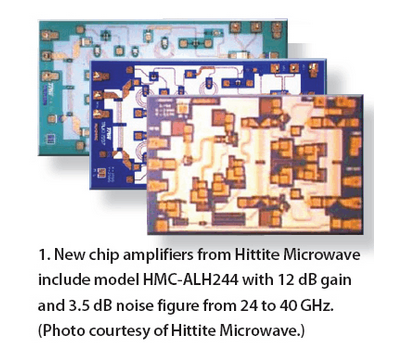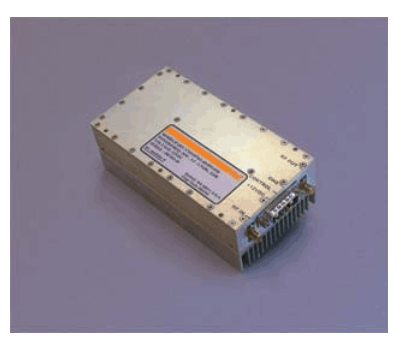Review of the performance of the main RF microwave amplifiers
作者:管ç†å‘˜ æ¥æºï¼šæœ¬ç«™ æµè§ˆæ•°ï¼š4060 å‘布时间:2016/9/28 16:22:02
There are a wide range of high-frequency amplifiers and a wide range of applications, and can be used in almost all electronic devices, such as setting the noise figure of the communication receiver and driving high-power signals for the signal transmitter antenna. Types of high-frequency amplifiers include wideband and narrowband power amplifiers, low-noise amplifiers (LNAs), logarithmic amplifiers, operational amplifiers, transimpedance amplifiers (TIAs), and variable voltage amplifiers. They exist in various forms such as chips, devices with surface mount (SMT) packages, rack-mounted systems based on solid-state and tube devices, and more. This article describes some of the recently released RF/microwave amplifier products.
Â
The smallest RF/microwave amplifiers are monolithic microwave integrated circuit (MMIC) devices. These devices are often used as gain modules to compensate for the loss of passive signals in systems and circuits. MMIC amplifier chips and MMIC amplifier modules in packages are available from a number of companies, including Agilent, ADI, Filtronic, Hittite Microwave, Microwave Technology, Mimix Broadband, Mini-Circuits, and RFMD.
Â
The HMC-ALH444 LNA chip from Hittite Microwave is ideal for commercial and military applications with a frequency range of 1~12GHz. The chip has a 10dB gain at 17GHz and a low noise figure of only 1.75dB. The company also introduced a GaAS high electron mobility transistor (HEMT) LNA chip at 65 GHz (Figure 1). HMCALH382 chip provides 21dB gain over the 57~65GHz frequency range with a noise figure of 4dB. The chip provides +12dBm of output power over a 1dB compression point while drawing only 64mA from a single-ended +2.5V DC supply.

Microwave Technology's MMA-021015 is another amplifier chip that utilizes AlGaAs/InGaAs pseudo-high electron mobility transistor (pHEMT) technology to achieve a noise figure of 4.8dB in the frequency range of 1~10GHz. The chip provides +17dBm output power and 18dB gain over the entire bandwidth with a gain flatness of +/- 2.5dB and is designed to operate in a +6V DC system. The company also offers a range of wideband mid-power amplifiers, including the MMA-022020B amplifier with 22.5dBm output power at 1dB compression point and 8dB gain at 1~22GHz.
Â
In terms of bandwidth performance, few other MMIC chip amplifiers can match Agilent Technologies' HMMC-5025. This distributed amplifier covers the 2~50GHz frequency range with 8.5dB small signal gain and +12dBm output power at 40GHz. The chip has a noise figure of only 35dB at the 5GHz frequency and 50dB at the 7GHz frequency. This seven-stage distributed amplifier chip has a gain control range of 30dB, and each stage includes two cascading GaAs FET devices.
Â
Many MMIC amplifier suppliers also offer amplifiers in packages. For example, Mimix Broadband's CMM9000-QT two-stage feedback driver amplifier for the 1.5~6.0GHz frequency range is available in a 3×3mm surface-mount QFN package. The amplifier has a small signal gain of 15dB, +15dBm output power over 1dB compression, and integrates on-chip matching circuitry, RF choke inductors, and DC isolation capacitors. Analog Devices offers ADL5320 and ADL5321 pre-driven amplifiers with 13.7dB gain and 4.2dB noise figure at 400~2,700 MHz operating frequency and 25.6dBm output power at 2,140MHz, and the latter with 14dB gain at 2,300~4,000MHz operating frequency and providing +25dBm output power with a noise figure of 4dB at 2,600MHz.

Mini-Circuits offers several MMIC amplifier product lines in packages, including the ERA series. Among the many miniature ERA amplifiers with SMT packages, the ERA-1 amplifier provides more than 10dB gain over the frequency range from DC to 8GHz and has a typical output power of +12dBm at the 1dB compression point. The general-purpose amplifier has a low noise figure of 4.3dB and a high linearity typical of +26dBm with a typical third-order intercept.
Â
Since these small MMIC amplifiers rarely deliver more than 0.5W (+27dBm), larger circuits and packages are required to deliver high power. In a slightly larger size range, many companies offer amplifiers with coaxial connectors in aluminum housings. This amplifier delivers higher power and dissipates more heat using the package and heat sink. For example, CTT offers narrowband and wideband power amplifiers for a wide range of commercial and military applications, covering the frequency range of 0.5~2.0GHz, 1.0~2.0GHz, 2~4GHz, 2~6GHz, 2~8GHz, 2~18GHz, and 2~20GHz, with output power up to +41dBm. Higher frequency models include the APW/265-3036 amplifier with 36dB gain over the 18.0~26.5GHz frequency range and +30dBm output power over the 1dB compression point.
Â
The emergence of commercial wide-bandgap semiconductor devices, such as those produced in silicon carbide (SiC) and gallium nitride (GaN) materials, provides amplifier design engineers with very high power density devices. For example, Milmega in the United Kingdom uses Cree's SiC transistors in its UHF power amplifiers. At these frequencies, SiC MESFETs have greater power density than competing transistor technologies, allowing for the design of higher power amplifiers in a smaller package.
Â
EMPOWER RF Systems' Model 1117-BBM3K5KEL power amplifier uses GaN high-power density devices. It has a typical output power of 20W at a 1dB compression point in the range of 500~2,500 MHz and provides 46dB gain and +/- 1.5dB gain flatness.
Â
Some power amplifiers rely on vacuum tubes rather than solid-state devices to produce high-power output. For instance, dB Control has launched a new MPM series, including the GHzdB-3757 amplifier with a duty cycle signal of 6% that delivers 1,500kW peak power in the 6~18GHz range.
Â
AR Worldwide's modular CMS1070 GaAs FET power amplifiers are available for WiMAX systems. It provides +43dBm output power at a 1dB compression point in the range of 3,400~3,700MH, with a variable gain of 20~50dB and a third-order cut-off point of +54dBm.
Â
For satellite communications and other high-frequency applications, Endwave offers a range of solid-state amplifiers. The company recently released a pair of amplifier modules for satellite communications (Figure 3) with a Ku-band unit that delivers at least 40 dB of gain with 0.5 dB gain flatness and +37 dBm typical output power at a 1 dB compression point; Its Ka-band module provides at least 27dB of gain with 1dB gain flatness and +36dBm output power at 1dB compression point. The noise figure of the module is very low, with a noise figure of 4.5dB for the Ku-band module and 6dB for the Ka-band module.
